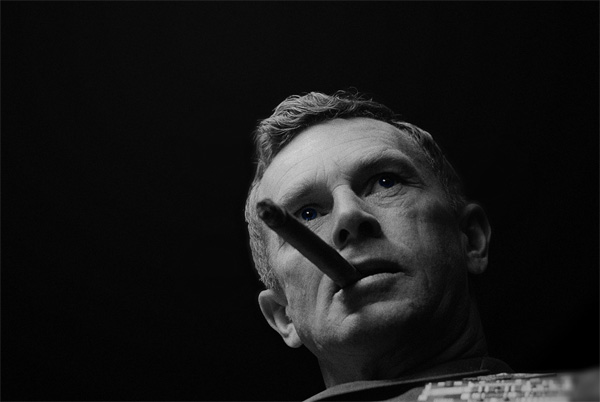On January 29, 1964, Stanley Kubrick‘s Dr. Strangelove: How I Learned to Stop Worrying and Love the Bomb premiered in the US and the UK, weeks later than originally planned. As the film’s Wikipedia entry puts it, following the assassination of JFK on November 22, 1963, “it was felt that the public was in no mood for such a film any sooner.”
In the run-up to a 50th anniversary screening in London, Sight & Sound presents a collection of behind-the-scenes shots and production designs by the remarkable Ken Adam. In her introduction, Sarah Cox notes that Kubrick’s fear of “the very real threat of nuclear war… led to fascination and by the time he began adapting Peter George’s cold war novel Red Alert into a film, he had collected more than 40 books on nuclear warfare…. Although the subject matter of the film was initially considered unsuitable for a black comedy, after attempting to write a serious interpretation of the novel Kubrick decided that the concept was so absurd it was impossible to make it as anything else.”
These designs and photos are lovely to look at, but what you really want to see today is the whopping package Eric Schlosser has dropped at the New Yorker‘s site. In his centerpiece article, “Almost Everything in Dr. Strangelove Was True,” he notes that film reviewers and military brass alike, whether or not they appreciated the comedy, denounced the premise as implausible. “The first casualty of every war is the truth,” writes Schlosser, “and the Cold War was no exception to that dictum. Half a century after Kubrick’s mad general, Jack D. Ripper, launched a nuclear strike on the Soviets to defend the purity of ‘our precious bodily fluids’ from Communist subversion, we now know that American officers did indeed have the ability to start a Third World War on their own. And despite the introduction of rigorous safeguards in the years since then, the risk of an accidental or unauthorized nuclear detonation hasn’t been completely eliminated.”
Schlosser would know. His latest book, Command and Control: Nuclear Weapons, the Damascus Accident, and the Illusion of Safety, has been met with alarmed praise from far and wide (including from the pages of the New Yorker), and this latest piece comes with the sort of collection of footnotes citing primary sources that could only be presented online. On another page, Schlosser comments on five clips from the film, and on yet another, he comments on clips from the 2010 documentary Always/Never: The Quest for Nuclear Safety, Control, and Survivability. To top it off, Sasha Weiss interviews Schlosser and Nicholas Thompson, author of The Hawk and the Dove: Paul Nitze, George Kennan, and the History of the Cold War (30’04”).
In March 1964, Jonathan Rosenbaum wrote what “may have been my first really serious film review.” See also Roger Ebert‘s 1994 review and Eric Henderson‘s for Slant in 2009.
Updates, 1/29: Today’s the day. Happy 50th, Dr. Strangelove. At Dangerous Minds, Paul Gallagher introduces the video below: “An original draft opened with extra-terrestrials viewing Earth after a nuclear holocaust. It was to be called The Delicate Balance of Terror. Kubrick then decided the film required a level of ‘inspired lunacy’ within a realistic framework. He therefore brought in ‘Existentialist hipster’ and controversial author of Candy, Terry Southern.”
And at Flavorwire, Jason Bailey writes up a list of “10 Things You Didn’t Know About Dr. Strangelove,” though chances are, you might well know one or two of them.
For news and tips throughout the day every day, follow @KeyframeDaily on Twitter and/or the RSS feed. Get Keyframe Daily in your inbox by signing in at fandor.com/daily.




